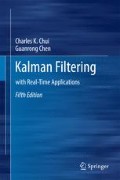Abstract
The Kalman filtering process has been designed to estimate the state vector in a linear model. If the model turns out to be nonlinear, a linearization procedure is usually performed in deriving the filtering equations. We will consider a real-time linear Taylor approximation of the system function at the previous state estimate and that of the observation function at the corresponding predicted position.
Access this chapter
Tax calculation will be finalised at checkout
Purchases are for personal use only
Author information
Authors and Affiliations
Corresponding author
Exercises
Exercises
-
8.1.
Consider the two-dimensional radar tracking system shown in Fig. 8.11, where for simplicity the missile is assumed to travel in the positive y-direction, so that \(\dot{x}=0,\dot{y}=v\), and \(\ddot{y}=a\), with v and a denoting the velocity and acceleration of the missile, respectively.
-
(a)
Suppose that the radar is located at the origin and measures the range r and angular displacement \(\theta \) where \((r,\ \theta )\) denotes the polar coordinates. Derive the nonlinear equations
$$\begin{aligned} {\left\{ \begin{array}{ll} \dot{r}=vsin\theta \\ \dot{\theta }=\frac{v}{r}cos\theta \end{array}\right. } \end{aligned}$$and
$$\begin{aligned} {\left\{ \begin{array}{ll} \ddot{r}=a \ sin\theta +\frac{v^{2}}{r^{2}}cos^{2}\theta \\ \ddot{\theta }=\left( \frac{ar-v^{2}sin\theta }{r^{2}}\right) cos\theta -\frac{v^{2}}{r^{2}}sin\theta \ cos\theta \end{array}\right. } \end{aligned}$$for this radar tracking model.
-
(b)
By introducing the state vector
$$\begin{aligned} \mathbf {x}:=\left[ \begin{array}{c} r\\ \dot{r}\\ \theta \\ \dot{\theta } \end{array}\right] , \end{aligned}$$establish a vector-valued nonlinear differential equation for this model.
-
(c)
Assume that only the range r is observed and that both the system and observation equations involve random disturbances \(\{\underline{\xi }\}\) and \(\{\eta \}\). By replacing \(\mathbf {x},\dot{\mathbf {x}},\ \underline{\xi }\), and \(\eta \) by \(\mathbf {x}_{k}\), \((\mathbf {x}_{k+1}-\mathbf {x}_{k})h^{-1}\), \(\underline{\xi }_{k}\), and \(\eta _{k}\), respectively, where \(h> 0\) denotes the sampling time, establish a discrete-time nonlinear system for the above model.
-
(d)
Assume that \(\{\underline{\xi }_{k}\}\) and \(\{\eta _{k}\}\) in the above nonlinear system are zero-mean uncorrelated Gaussian white noise sequences. Describe the extended Kalman filtering algorithm for this nonlinear system.
-
(a)
-
8.2.
Verify that the nonlinear model (8.1) can be approximated by the linear model (8.3) using the matrices and vectors defined in (8.5) and (8.7).
-
8.3.
Verify that the extended Kalman filtering algorithm for the nonlinear model (8.1) can be obtained by applying the standard Kalman filtering equations (2.17) or (3.25) to the linear model (8.3) as shown in (8.8).
-
8.4.
Verify equation (8.13).
-
8.5.
Verify equation (8.14).
-
8.6.
Verify the algorithm given in (8.15).
-
8.7.
Prove that if the unknown constant vector \(\underline{\theta }\) in the system (8.10) is deterministic (i.e., \(\underline{\theta }_{k+1}=\underline{\theta }_{k}\) for all k), then the algorithm (8.15) fails to identify \(\underline{\theta }\).
-
8.8.
Consider the one-dimensional model
$$\begin{aligned} {\left\{ \begin{array}{ll} x_{k+1}=x_{k}+\xi _{k}\\ v_{k}=c\, x_{k}+\eta _{k}, \end{array}\right. } \end{aligned}$$where \(E(x_{0})=x^{0},\ Var(x_{0})=p_{0},\ \{\xi _{k}\}\) and \(\{\eta _{k}\}\) are both zero-mean Gaussian white noise sequences satisfying
$$\begin{aligned}&E(\xi _{k}\xi _{\ell })=q_{k}\delta _{k\ell },\quad E(\eta _{k}\eta _{\ell })=r_{k}\delta _{k\ell },\\&E(\xi _{k}\eta _{\ell })=E(\xi _{k}x_{0})=E(\eta _{k}x_{0})=0. \end{aligned}$$Suppose that the unknown constant c is treated as a random constant:
$$\begin{aligned} c_{k+1}=c_{k}+\zeta _{k}, \end{aligned}$$where \(\zeta _{k}\) is also a zero-mean Gaussian white noise sequence with known variances \(Var(\zeta _{k})=s_{k}\). Derive an algorithm to estimate c. Try the special case where \(s_{k}=s>0\).
Rights and permissions
Copyright information
© 2017 Springer International Publishing AG
About this chapter
Cite this chapter
Chui, C.K., Chen, G. (2017). Extended Kalman Filter and System Identification. In: Kalman Filtering. Springer, Cham. https://doi.org/10.1007/978-3-319-47612-4_8
Download citation
DOI: https://doi.org/10.1007/978-3-319-47612-4_8
Published:
Publisher Name: Springer, Cham
Print ISBN: 978-3-319-47610-0
Online ISBN: 978-3-319-47612-4
eBook Packages: Physics and AstronomyPhysics and Astronomy (R0)


